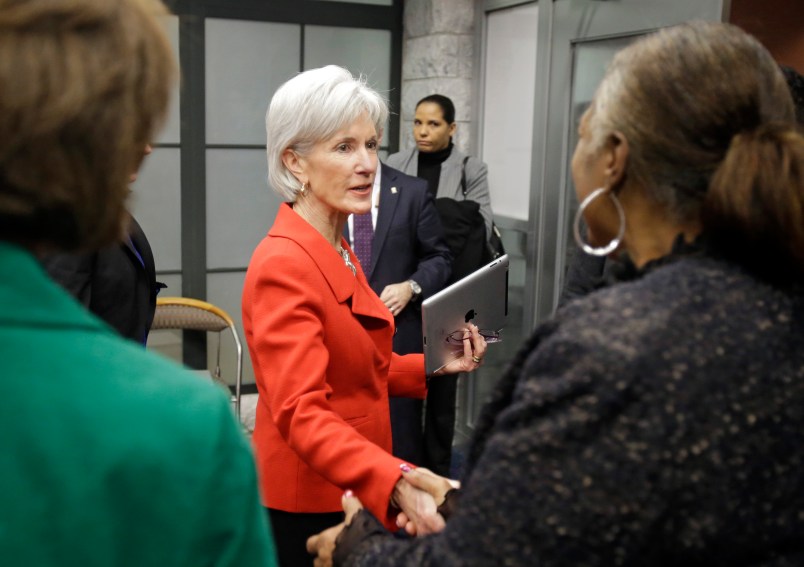WASHINGTON (AP) — Uninsured Americans are still procrastinating about President Barack Obama’s health care law. With fewer than 60 days left to enroll, can the administration find the millions of customers needed to sustain new insurance markets?
Geography could hold the answer, according to a study conducted for The Associated Press. It found theuninsured aren’t scattered around the country willy-nilly; half live in just 116 of the nation’s 3,143 counties. That means an outreach campaign targeted to select areas can pay off big.
The pattern also holds true for the younger uninsured, the health care overhaul’s most coveted demographic. The study found that half the uninsured people ages 19-39 live in 108 counties. Their premiums are needed to offset the cost of insuring older adults, who are more likely to be nursing chronic ailments.
With the HealthCare.gov website working more smoothly, the Obama administration is using the geography of the uninsured to write a playbook for its closing sign-up campaign. Open enrollment for subsidized private insurance ends March 31 for people who don’t have health care through their jobs.
“Our efforts are aimed at making sure we can raise awareness in areas with the largest concentration ofuninsured people,” said Julie Bataille, communications director for the rollout at the federal Health and Human Services Department.
The administration has done its own geographical research, drilling down even below the county level. Officials said the pattern coincides with the findings of AP’s study, which was conducted by the State Health Access Data Assistance Center at the University of Minnesota.
Federal officials have identified 25 key metro areas to focus on. The top two are in Texas: Dallas and Houston. Next come Miami and Atlanta. In the Northeast, the northern New Jersey megalopolis and Philadelphia are on the list. Midwest markets include Detroit, Cleveland and Indianapolis. Southern cities also include Nashville, Tenn., and Charlotte, N.C. Washington is largely steering clear of states that are leading their own sign-up efforts, such as California, New York and Illinois.
Officials use the spreadsheets to define enrollment tactics in states where Washington is taking the lead. The numbers help determine where to send HHS Secretary Kathleen Sebelius to pitch the law overall and plug local sign-up events. They’re also guiding the placement of television ads aimed at younger people, scheduled to start airing as the Winter Olympics open this week.
The research for the AP by the Minnesota health data center found that just 13 counties account for 20 percent of the uninsured. The top county, Los Angeles, has more than 2 million uninsured people, or about 5 percent of the national total.
“To reduce the number of uninsured people, you have to focus on those states where the largest populations ofuninsured people live,” said Lynn Blewett, the center’s director. Uninsured Americans generally live in major metro areas where most of the overall population is concentrated.
But data-driven research can also help in rural areas with seemingly low numbers of uninsured people, said Brett Fried, a senior researcher at the center. Census files that provide coverage information at the ZIP code level can be used to tease out concentrations of uninsured people in sparsely populated states. Bataille said the HHS has an outreach effort tailored to rural areas.
The Minnesota researchers used government data from the 2011 Small Area Health Insurance Estimates, census data that is the only source of annual estimates of uninsured people for all counties. They were not able to filter out people who entered the country illegally and thus are not eligible for coverage under the law. Blewett said that group, although numerous, is not large enough to skew the overall geographic pattern.
High on the list of places with lots of uninsured people is Cook County, Ill., which includes Chicago. It ranks third nationally in the total number of uninsured, and third in uninsured young adults, with more than 460,000, the study found.
Among them is Katina Rapier, who recently filled out her paperwork during an Enroll America event at her community college. Enroll America is a nonprofit that works closely with the administration.
At 25, Rapier aspires to own a chain of women’s clothing stores. But she’s been uninsured since she turned 18 and says it’s a struggle to afford her vitally important asthma medication. She thought she had missed the deadline to apply for coverage, not realizing that open enrollment runs through the end of March.
“If it can help me get safe medication, I’m all for it,” Rapier said of the health care law.
No matter what the numbers say, she doesn’t think the administration will have an easy time signing up young adults. “They think health is something that you worry about when you get older,” Rapier said.
The White House originally set a goal of signing up 7 million people for coverage through the new insurance markets, and the administration says it has reached the 3 million mark.
But website problems — federal as well as state — have cast doubt on whether original goal will be met. The source for the 7 million target, the Congressional Budget Office, says it now expects 6 million people to sign up in 2014.
The CBO says its analysts expect a surge as March 31 draws near. With something so new, and so volatile, anything could happen.
“It is possible that the number of enrollees will reach the 7 million originally projected for 2014.” the budget office said in a report this week. “Just as it is possible that the number will fall short of the current estimate of 6 million.”
___
AP Medical Writer Carla K. Johnson in Chicago contributed to this report.
Copyright 2014 The Associated Press. All rights reserved. This material may not be published, broadcast, rewritten or redistributed.









